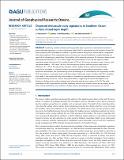Observed mesoscale eddy signatures in Southern Ocean surface mixed-layer depth
Author(s)
Hausmann, U.; McGillicuddy, Dennis J.; Marshall, John C
DownloadHausmann_et_al-2017-Journal_of_Geophysical_Research__Oceans.pdf (7.292Mb)
PUBLISHER_POLICY
Publisher Policy
Article is made available in accordance with the publisher's policy and may be subject to US copyright law. Please refer to the publisher's site for terms of use.
Terms of use
Metadata
Show full item recordAbstract
Combining satellite altimetry with Argo profile data a systematic observational estimate of mesoscale eddy signatures in surface mixed-layer depth (MLD) is provided across the Southern Ocean (SO). Eddy composite MLD anomalies are shallow in cyclones, deep in anticyclones, and increase in magnitude with eddy amplitude. Their magnitudes show a pronounced seasonal modulation roughly following the depth of the climatological mixed layer. Weak eddies of the relatively quiescent SO subtropics feature peak late-winter perturbations of ±10 m. Much larger MLD perturbations occur over the vigorous eddies originating along the Antarctic Circumpolar Current (ACC) and SO western boundary current systems, with late-winter peaks of −30 m and +60 m in the average over cyclonic and anticyclonic eddy cores (a difference of ≈ 100 m). The asymmetry between modest shallow cyclonic and pronounced deep anticyclonic anomalies is systematic and not accompanied by corresponding asymmetries in eddy amplitude. Nonetheless, the net deepening of the climatological SO mixed layer by this asymmetry in eddy MLD perturbations is estimated to be small (few meters). Eddies are shown to enhance SO MLD variability with peaks in late winter and eddy-intense regions. Anomalously deep late-winter mixed layers occur disproportionately within the cores of anticyclonic eddies, suggesting the mesoscale heightens the frequency of deep winter surface-mixing events along the eddy-intense regions of the SO. The eddy modulation in MLD reported here provides a pathway via which the oceanic mesoscale can impact air-sea fluxes of heat and carbon, the ventilation of water masses, and biological productivity across the SO.
Date issued
2017-01Department
Massachusetts Institute of Technology. Department of Earth, Atmospheric, and Planetary SciencesJournal
Journal of Geophysical Research: Oceans
Publisher
American Geophysical Union (AGU)
Citation
Hausmann, U. et al. “Observed Mesoscale Eddy Signatures in Southern Ocean Surface Mixed-Layer Depth.” Journal of Geophysical Research: Oceans 122, 1 (January 2017): 617–635 © 2016 American Geophysical Union
Version: Final published version
ISSN
2169-9291